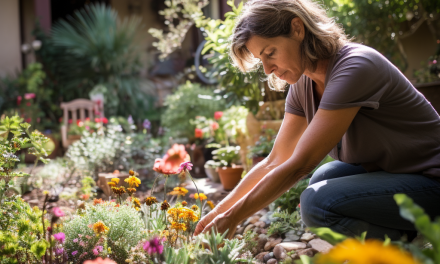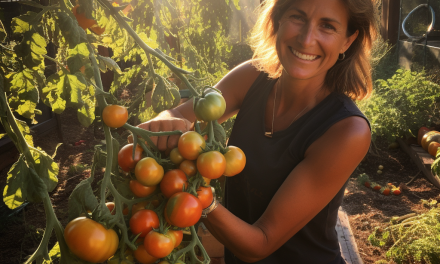Welcome, dear readers, to the enchanting world of home herb gardening, where the verdant allure of nature meets the delectable joys of the culinary arts. I’m Gayle the Gardener, and today, I invite you to join me on a journey that will transform the way you experience flavors in your meals.
Just as a maestro skillfully composes a symphony, or an artist paints a masterpiece, cultivating your own herb garden allows you to infuse your dishes with the freshest, most aromatic notes straight from your garden. With every snip of a fragrant leaf and every sprinkle of nature’s bounty into your recipes, you’ll embark on a sensory adventure that transcends the ordinary.
In the following pages, we will delve into the secrets of selecting the perfect herbs, tending to them with care throughout the seasons, and savoring the fruits of your labor as you elevate your culinary creations. Whether you have acres of land or a cozy corner on your balcony, I’m here to guide you on this flavorful journey, nurturing your green thumb and awakening your taste buds.
So, prepare to embark on a quest that will enrich not only your meals but also your connection to the natural world. Let’s explore the art of home herb gardening, and by the end of this guide, you’ll be well on your way to creating flavorful masterpieces that bear your personal touch, just like the gardening legends we all admire.
Shall we begin our herbaceous adventure?
Selecting the Right Herbs: A Symphony of Flavors
Now that we’ve set the stage for our herbaceous journey, let’s dive right into the heart of our garden – the herbs themselves. Just as a composer selects the instruments for their symphony, and an artist chooses their palette, the herbs you select will be the stars of your culinary show.
The Importance of Herb Selection
In the world of home herb gardening, the selection of herbs is akin to choosing the cast of characters for a compelling story. Each herb brings its own unique personality and flavor profile to the table, and the art lies in creating harmonious combinations that delight the senses.
Popular Herbs for Beginners
For those new to the world of herb gardening, starting with a few well-loved and easy-to-grow herbs is a wise choice. These herbs not only flourish with relative ease but also provide a robust palette of flavors to enhance your culinary creations. Some favorites among beginners include:
Basil: With its sweet and slightly peppery notes, basil is a staple in Italian cuisine and makes an excellent addition to salads and pasta dishes.
Rosemary: This fragrant herb adds a touch of earthiness to roasted meats and vegetables, lending a Mediterranean flair to your dishes.
Mint: Refreshing and versatile, mint is perfect for crafting invigorating teas, cocktails, or desserts.
Thyme: Known for its subtle earthy aroma, thyme complements a wide range of savory dishes, from roasted chicken to stews.
Complementing Your Herb Garden
Just as the finest orchestras balance their instruments, consider how your chosen herbs will complement each other. For instance, basil and tomato plants thrive together, creating a symbiotic relationship that enhances both flavors.
As we continue our journey, we’ll explore the specifics of caring for each herb, ensuring they reach their full potential in your garden.
So, Gayle the Gardener, as you embark on your herb gardening adventure, remember that the key to a successful herb garden is selecting the right herbs that resonate with your taste and style. In the next section, we’ll move on to preparing the perfect environment for your chosen herbs to flourish.
Preparing Your Herb Garden: Nurturing Nature’s Bounty
With our selection of herbs carefully curated, it’s time to turn our attention to the canvas upon which we’ll paint our herbaceous masterpiece. The preparation of your herb garden is the stage-setting act, and getting it right is essential for your herbs to thrive.
Choosing the Perfect Location
Just as a painter selects the ideal backdrop for their artwork, the location of your herb garden matters immensely. Here are some considerations:
Sunlight: Most herbs thrive in full sun, so choose a spot that receives at least 6-8 hours of direct sunlight each day. Herbs, like actors on a well-lit stage, will flourish in these conditions.
Soil Preparation: Like a composer tuning their instruments, prepare your soil by enriching it with organic matter. Herbs prefer well-drained, slightly alkaline soil. You can amend your soil with compost to create a fertile base for your garden.
Container Gardening: If space is limited, consider container gardening. Choose pots or containers with proper drainage to ensure your herbs have the space they need to shine.
The Importance of Proper Drainage
Just as a drainage system prevents a garden from flooding, your herb garden needs adequate drainage to prevent waterlogged roots. Elevated garden beds or containers with drainage holes can be excellent solutions. You want your herbs to be well-hydrated, not waterlogged.
As you prepare your herb garden, think of it as setting the stage for a grand performance. Your herbs will be the stars, and the environment you create for them will determine the quality of their act.
In the next section, Gayle the Gardener, we will explore the actual process of planting and caring for your herbs, ensuring that your garden is well-prepared to nurture these flavorful treasures.
Planting and Caring for Your Herbs: Nurturing Nature’s Symphony
Now that your herb garden’s stage is set, it’s time to introduce the star performers – your herbs. Planting and caring for these precious green wonders requires a gentle touch and a keen understanding of their needs, much like nurturing young talent in the world of performing arts.
The Planting Process
Prepare the Soil: Just as a conductor ensures the orchestra is in tune, begin by loosening the soil in your chosen location. If you’re using containers, fill them with a quality potting mix.
Spacing: Herbs need room to breathe and grow. Allow enough space between each plant, typically about 12 to 18 inches, to ensure they don’t compete for nutrients and light.
Planting Depth: Like an actor hitting their mark, your herbs should be planted at the same depth they were in their nursery containers. Gently remove the plant from its pot and place it in the hole, patting the soil down around it.
Watering: After planting, give your herbs a good drink of water. Think of it as providing them with a refreshing sip before their performance.
Caring for Your Herb Garden
Watering: Herbs appreciate consistent moisture, but they don’t like to be waterlogged. Water when the soil surface feels dry to the touch, ensuring that the water reaches the roots.
Sunlight: Like performers basking in the spotlight, herbs require sunlight to thrive. Ensure they continue to receive the necessary 6-8 hours of sunlight daily.
Pruning and Harvesting: Just as actors require direction, herbs benefit from regular pruning. Pinch or trim the leaves to encourage bushier growth and a more bountiful harvest. Harvest herbs when they’re at their peak, usually in the morning when their flavors are most intense.
Mulching: Mulch around your herbs to help retain moisture, regulate soil temperature, and suppress weeds. Mulch acts like a backstage crew, supporting your herbs from behind the scenes.
Remember, Gayle the Gardener, caring for your herb garden is a labor of love. As you nurture your herbs, you’ll witness their growth and transformation, much like watching a talented artist or performer develop their craft.
In the next section, we’ll delve into the intricacies of year-round herb garden care, ensuring your garden remains a vibrant source of flavors and aromas.
Year-Round Herb Garden Care: Sustaining the Symphony
As any seasoned performer knows, the show must go on, regardless of the season. Your herb garden is no different. To maintain a lush and flavorful garden year-round, you’ll need to become the conductor, guiding your herbs through each seasonal act.
Seasonal Care and Maintenance
Spring
- Pruning and Fertilizing: As spring breathes new life into your garden, prune your herbs to encourage fresh growth. Apply a balanced, organic fertilizer to provide essential nutrients.
Summer
- Watering: The warm summer months may require more frequent watering. Keep a close eye on soil moisture to prevent drought stress.
Fall
- Harvesting: Continue to harvest herbs, but be mindful of not overharvesting, as plants prepare for winter dormancy.
Winter
- Protection: In colder climates, consider covering your herb garden with mulch or a frost cloth to shield your herbs from freezing temperatures.
Pruning and Harvesting Techniques
Regular Pruning: Pinch or trim your herbs regularly to prevent them from becoming leggy. This not only maintains their shape but also encourages fresh growth.
Morning Harvest: Just as a chef selects the freshest ingredients for their menu, harvest your herbs in the morning when their essential oils are at their peak, ensuring maximum flavor.
Overwintering Options
Indoor Herb Garden: For those in colder regions, consider bringing potted herbs indoors to enjoy fresh herbs throughout the winter.
Protective Coverings: Covering your outdoor herb garden with materials like burlap or cloths can shield your herbs from harsh winter conditions.
Much like a seasoned actor rehearsing for different roles, your herb garden requires your attention and care as the seasons change. By adapting to the needs of your herbs, you’ll ensure a continuous supply of fresh flavors for your culinary creations.
Infusing Flavor into Your Meals: A Culinary Masterpiece
Congratulations, dear reader and fellow gardening enthusiast! You’ve successfully nurtured your herb garden through the seasons, and now it’s time to reap the flavorful rewards. Just as a chef crafts exquisite dishes, you’ll use your homegrown herbs to elevate your meals to new heights.
Culinary Tips and Recipe Ideas
1. Fresh Herb Garnishes:
- Enhance the visual appeal and taste of your dishes by garnishing with fresh herb leaves. Sprigs of basil, rosemary, or cilantro can add a burst of color and flavor to salads, soups, and entrees.
2. Herb-Infused Oils and Vinegars:
- Create your own herb-infused oils and vinegars by steeping fresh herbs in olive oil or vinegar. These make delightful dressings or marinades for salads and grilled vegetables.
3. Herb-Butter Blends:
- Mix finely chopped herbs into softened butter for a delicious herb butter. Spread it on bread, use it to baste roasted poultry, or melt it over steamed vegetables.
4. Herbal Teas and Cocktails:
- Experiment with herbal teas and cocktails by using fresh mint, lemon verbena, or chamomile from your garden. These beverages offer a refreshing twist to your drink menu.
5. Herb-Infused Desserts:
- Don’t forget about dessert! Add finely chopped herbs like lavender, basil, or mint to your baked goods or ice creams for a unique and delightful taste.
The Satisfaction of Homegrown Herbs
Much like an artist using their own palette, the flavors of homegrown herbs are yours to blend and experiment with. The satisfaction of plucking a sprig of basil or rosemary from your garden and infusing it into your dish is a culinary experience like no other.
As Gayle the Gardener, you’ve not only cultivated a garden but also cultivated a deep connection between nature and your kitchen. Your meals will now bear the distinct mark of your green thumb and your culinary creativity.
With your herb garden flourishing and your culinary skills blossoming, you’re ready to compose flavorful masterpieces that reflect your unique style.
Conclusion: Embrace the Herbaceous Journey
As we come to the final act of our herbaceous journey, it’s time to reflect on the symphony of flavors and scents you’ve cultivated in your own home herb garden. You, dear reader, have embraced the art of herb gardening, just as Gayle the Gardener has. Together, we’ve uncovered the secrets of selecting, planting, and caring for herbs that not only thrive but also enrich your culinary experiences.
In your garden, you’ve become the conductor, guiding each herb to reach its full potential. In your kitchen, you’ve become the chef, skillfully blending fresh herbs into your dishes, turning ordinary meals into extraordinary culinary creations.
As you savor the flavors of your homegrown herbs, remember that the journey has only just begun. With each season that passes, your garden will continue to evolve and offer new opportunities for experimentation and growth.
Your Next Steps
Now, it’s time for you to take the baton and embark on your own herb-growing adventure. Here are some steps to get you started:
Select Your Herbs: Choose the herbs that resonate with your taste and style. Experiment with unique combinations to create your own herb garden symphony.
Prepare Your Garden: Whether you have a spacious backyard or a tiny balcony, create the ideal environment for your herbs to thrive.
Plant and Care: Follow the planting and care guidelines we’ve explored in this guide to nurture your herbs through the seasons.
Culinary Creativity: Infuse your meals with the fresh flavors of your homegrown herbs. Explore new recipes and share your culinary creations with friends and family.
Connect with Nature: Embrace the connection between your garden and your kitchen. Witness the magic that happens when you grow your own ingredients.
Remember, the world of herb gardening is a lifelong journey, much like the careers of the performers we admire. With each harvest, each meal, and each season, you’ll deepen your understanding of nature’s bounty and the delightful art of flavor infusion.
So, Gayle the Gardener, I encourage you and your fellow readers to embrace this herbaceous journey with open arms and a joyful heart. Your herb garden is not just a source of flavors; it’s a testament to your passion for nature and the culinary arts.
As you continue your journey, may your meals always be infused with the love and dedication you’ve poured into your garden. Happy herb gardening and bon appétit!
Amazon and the Amazon logo are trademarks of Amazon.com, Inc, or its affiliates.AMAZON AFFILIATE DISCLOSURE The Garden Whisperer Tips blog is a participant in the Amazon Services LLC Associates Program, an affiliate advertising program designed to provide a means for sites to earn advertising fees by advertising and linking to Amazon.com. As an Amazon Associate, we earn from qualifying purchases. Some of the links on this blog are affiliate links, and if you go through them to make a purchase, we will earn a commission at no extra cost to you. AFFILIATE MARKETING AND ADVERTISEMENT TRANSPARENCY At Garden Whisperer Tips, we believe in full transparency with our readers. We participate in multiple affiliate marketing programs, and some of the links on this blog may be affiliate links. This means we may earn a commission if you click on the link or make a purchase using the link. We also host advertisements on our blog, which helps us generate revenue. Rest assured, our editorial content is not influenced by advertisers or affiliate partnerships.





